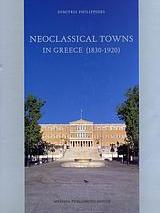Ο Δημήτρης Φιλιππίδης (γ. 1938) είναι αρχιτέκτονας (ΕΜΠ, 1962), μετά το 1975 καθηγητής πολεοδομίας και σήμερα ομότιμος καθηγητής της Σχολής Αρχιτεκτόνων ΕΜΠ. Εργάστηκε σε διάφορα γραφεία εκπονώντας αρχιτεκτονικές και πολεοδομικές μελέτες (1964-1995) και διακρίθηκε σε διαγωνισμούς. Έχει δημοσιεύσει άρθρα και κριτικές βιβλίων για την ελληνική παραδοσιακή και σύγχρονη αρχιτεκτονική, την πολεοδομία και την εκπαίδευση των αρχιτεκτόνων. Έχει γράψει δεκαπέντε βιβλία: "Νεοελληνική αρχιτεκτονική" (1984), "Για την ελληνική πόλη" (1990), "Είκοσι θέσεις για την πολεοδομία" (1990), "Το σκυρόδεμα στην ελληνική αρχιτεκτονική του εικοστού αιώνα" (1992), "Μεσογειακά σπίτια: Ελλάδα" (1994), "Λύσανδρος Καυταντζόγλου" (1995), "Πέντε δοκίμια για τον Κωνσταντινίδη" (1997), "Διακοσμητικές τέχνες" (1998), "Μοντέρνα αρχιτεκτονική στην Ελλάδα" (2001), "Προάστια και εξοχές της Αθήνας του '30" (2006), "Αρχιτεκτονικές μεταμορφώσεις" (2006), "Νεοκλασικές πόλεις στην Ελλάδα" (2007), "Οικοδομικό τετράγωνο 19 (2009), "Εφήμερη και αιώνια Αθήνα" (2009), "Δημήτρης Πικιώνης" (2009). Έχει επιμεληθεί αφιερώματα και μονογραφίες αρχιτεκτόνων, καθώς και τους έξι πρώτους τόμους της σειράς "Ελληνική Παραδοσιακή Αρχιτεκτονική" (1980-1988).






